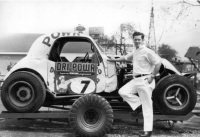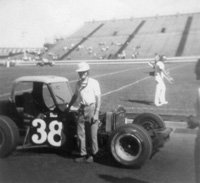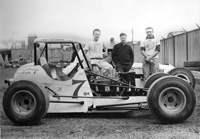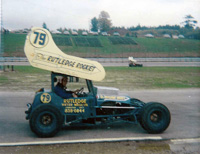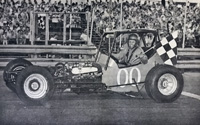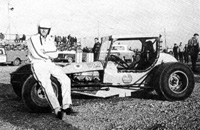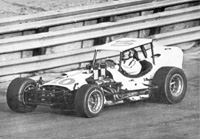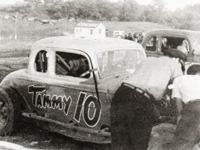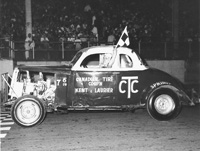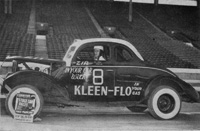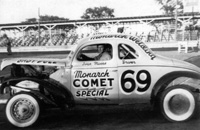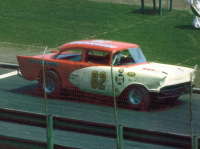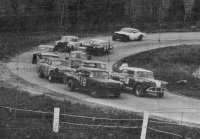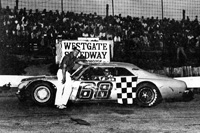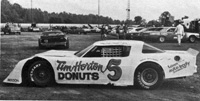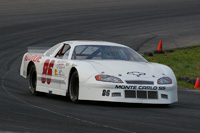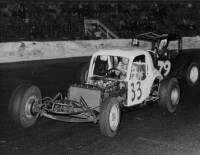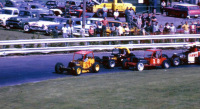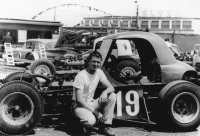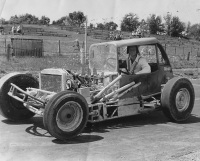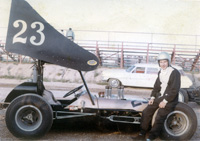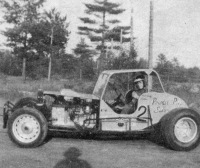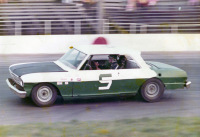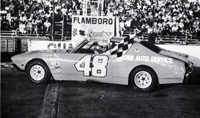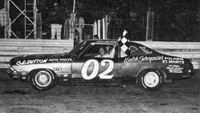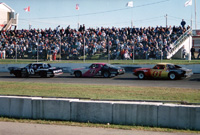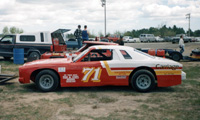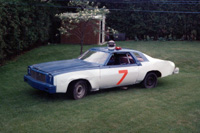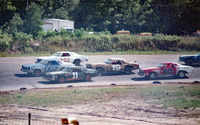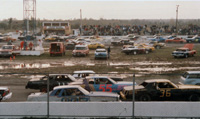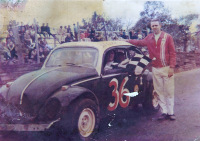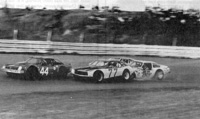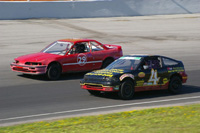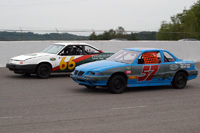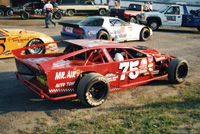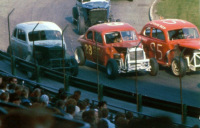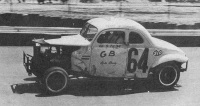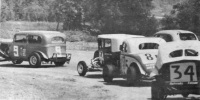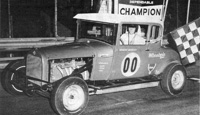
If you are the copyright holder
of any of the photos on this page and don't wish to have it on this website, contact
webmaster@canadianracer.com and
I will remove it. Otherwise, thank you for your contribution to Canadian racing
history.
Introduction
In order to keep this article to a reasonable size, it will focus on stock car classes on paved tracks in Southern Ontario. Dirt track racing started out with similar classes in the early 1950s but by the mid-1960s the classes had diverged. Until that time it was common for a driver to switch between a paved track and a dirt track with the same car. Not all classes will be covered in this article. Some tracks had a class that was unique to them. The article will focus on the common classes that ran throughout Ontario on the regular race program. Touring classes and series will be covered in future articles. Although the article focuses on Southern Ontario, similar evolution was happening all across Canada.
Pre-War Racing
For the first half of the 20th Century oval track racing was done primarily on half-mile or larger horse tracks, usually located at a fairground. Many fairgrounds across Canada ran races; some examples from Ontario were Essex, the Canadian National Exhibition, Western Fairgrounds (London), Leamington, plus many more.
There were predominantly two types of cars: "Big" Cars and midgets. Midgets would be recognized today as being very similar to a modern midget. "Big" Cars could best be compared to a sprint car today. The "Big" Cars and Midgets tended to be touring groups that were brought in by the local promoter for special events, usually only a few times a year.
The Rise of Stock Car Racing
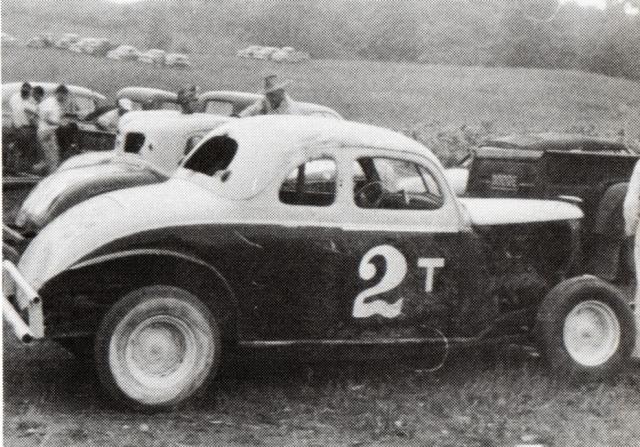
Chuck Walker at Delaware in the early 1950s. A typical stock car of the era.
Some of those early Ontario tracks included Brodie's Delaware Raceway (now Delaware Speedway), Ascot Park Speedway (Tillsonburg), Bluewater Speedway (Port Elgin), Bridgeport Speedway (Kitchener), CNE Speedway (Toronto), Ailsa Craig, Dayus Raceway (Windsor), Merrittville Speedway, Mohawk Speedway (Brantford), Nilestown, Oshawa, Pinecrest (Concord), Pleasure Valley (Oshawa), Speedway Park (Concord), St. Thomas Raceway, Ridgetown Raceway, Warwick Raceway and Tilbury Speedway. Many of these tracks did not survive past the 1950s but stock car racing took hold in Ontario and many more tracks were built in the years that followed.
The cars at that time were mostly all 1930s coupes and coaches. There is a direct line from these race cars of the late 1940s and early 1950s to the Canadian Vintage Modifieds of today. There was only one class in those days and they were just usually referred to as "stock cars" or "stox". If a track had enough cars, they might be divided into an "A" Class (the faster cars) and a "B" Class (the slower cars) but the cars were basically the same.
The Continuous Cycle Begins
Prominent Super Modified Drivers of the 1950s and 1960s
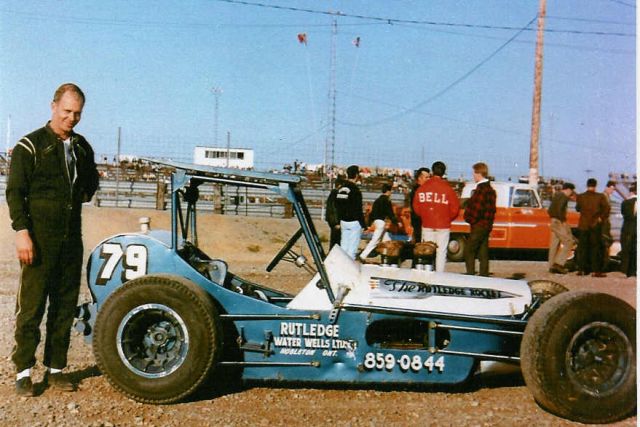
It didn't take long for a separate class to emerge. By the mid-1950s the cars were starting to get cut-down, narrowed, stripped of fenders and bumpers, etc and engines heavily modified. These cars were the forefathers of today's Super Modified. These changes weren't happening at all tracks though - mostly at the more prestigious tracks like CNE Speedway, Nilestown, Bridgeport, Lansdowne and Pinecrest Speedway. At many of the smaller tracks, the 1930s coupes and coaches carried on as the main class well into the 1960s.
Ted Hogan
Jack Greedy
Harvey Lennox
Al Mitchell
Jimmy Howard
Gary Witter
Jack Greedy
Harvey Lennox
Al Mitchell
Jimmy Howard
Gary Witter
Howie Scannell
Jack McCutcheon
Don Fleming
Sam Snider
Norm Mackereth
Joe Hlywka
Jack McCutcheon
Don Fleming
Sam Snider
Norm Mackereth
Joe Hlywka

Sam Snider at Flamboro, 1966
Not all the drivers wanted to spend the kind of money that was necessary to keep up, so in a move that would be repeated thousands of times over the next 50 years at tracks all across North America, the CNE introduced a new, low-cost, entry-level class called "Amateur" and the top class was called "Modified". Pinecrest followed in 1957, introducing the "Jalopy" class and Bridgeport did the same in 1958. Amateurs, Jalopies or Hobbies were names used at various tracks but they were always the 1930s coupes and coaches that were basically stock. Hobby Car was the name that eventually stuck.
The Modifieds continued to evolve in the 1960s until they became very expensive and became known as Super Modifieds. Some drivers even purchased a used Indy Car and with a few modifications, would run it as a Super Modified.
The Evolution of the Super Modified
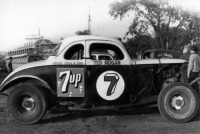

Ted Hogan at the CNE, 1956
This was the year that the rulebook was opened up for the engines. The cars were starting to get stripped of extra body work - the fenders and running boards are gone from previous years.
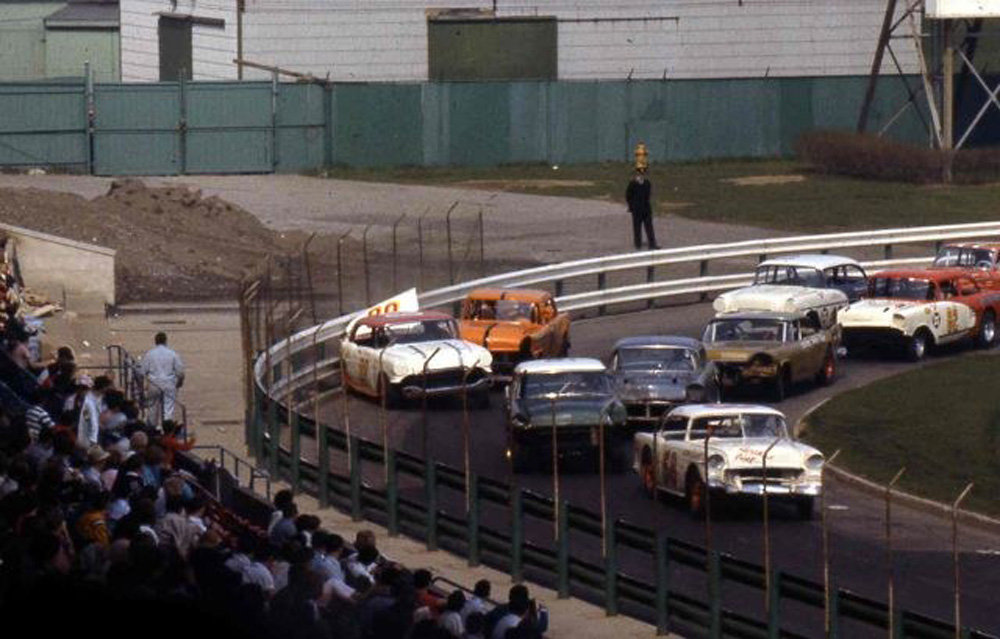
The first Late Models at the CNE, sometime between 1964 and 1966
While the Late Models became the new top class at most tracks in Ontario, many tracks kept the Hobbies as well. Tracks that ran the Hobby Class in the 1960s and 1970s included CNE (until closing in 1966), Westgate (now Peterborough Speedway), Speedway Park, Nilestown, Flamboro, Delaware, Hide-A-Way and Grand River. The Hobby Class was dropped by some of the tracks and other tracks closed, leaving Hobbies at only Delaware (where they had evolved somewhat and were called Sportsman Modified), Speedway Park, Westgate and Flamboro. By the 1976 season the Hobbies had all gathered at Flamboro and ran under the organization of the Ontario Amateur Racing Club (OARC), known today the Canadian Vintage Modifieds. The OARC was formed in late 1966 and eventually, by the 1970s, had Flamboro as its home track and often made visits to other speedways.
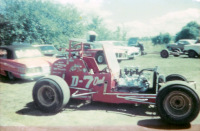
Dick Mahoney's "B" Modified in the pits at Sutton
As the cost of Super Modifieds became too high, a new class emerged called the "B" Modified. Sometimes called "B" Bombers or "B" Bombs, they were essentially a Super Modified chassis and body with a 6 cylinder or flathead 8 cylinder engine. It was an attempt to keep the look of the Super Modified at a more affordable price. The cost to build a "B" Modified at the time was about $1000 compared to $3000-$5000 (or more) for a Super. They only raced at a few tracks, namely: Sutton, Wasaga and Sunset. The "B" Modifeds were dropped by both Sunset and Sutton after the 1967 season. The class continued to run at Wasaga until the track closed in 1970.
Two other new classes appeared in the late 1960s: Mini-Stocks and Diamonds. The Diamond Class was a less expensive version of a Late Model. Diamonds originated at Barrie Speedway in 1966 and soon appeared at many tracks in Ontario. They were sometimes referred to as Diamond Late Models. By the mid-1970s most tracks were calling this class the Limited Late Model division. Some tracks ran a Diamond 6 Cylinder Class as well.
The Mini-Stock Class was dominated by Austin Minis and VW Beetles. Cayuga ran this class on the small, inner oval. They were also a regular class at Acton, Ascot Park, Nilestown, Speedway Park, Varney and Wasaga. The cars were fairly close to stock. They only raced at Varney for the 1970 season. Cayuga was the only other track of the group to last past 1975 and the Mini-Stocks stayed until the track stopped running a weekly program at the end of the 1979 season. The Cayuga Mini-Stock racers formed the Ontario Mini Stock Association in 1980 and became a touring series. In the late 1970s Sauble also introduced Mini-Stocks and Varney brought them back.
A variation of the Mini-Stocks was the Compact Division or Late Model Compacts that appeared at some tracks in the mid-1970s. These were predominantly Pintos, Gremlins and Vegas. Delaware evolved their Sportsman Modified Division (the old coupes) into the Compact Division during the 1974 season with the old coupes completely gone for 1975. In addition to Delaware, Compacts were regular classes at Cayuga and Flamboro. The Compacts died out by the late 1970s.
Prominent Late Model Drivers of the 1960s and 1970s
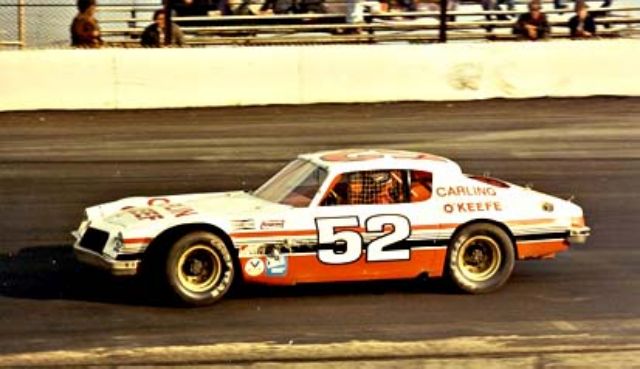
Don Biederman
Junior Hanley
Norm Lelliott
Earl Ross
Jack Monaghan
Jerry Makara
Junior Hanley
Norm Lelliott
Earl Ross
Jack Monaghan
Jerry Makara
Brian Setterington
Ross Howes
Howie Scannell
Doug Warnes
Jack Cook
George Reuffer
Ross Howes
Howie Scannell
Doug Warnes
Jack Cook
George Reuffer

Earl Ross, 1975
While the new classes were appearing, the Late Models continued to evolve at some tracks. Cayuga started calling their top class "Late Model Super Stocks" in 1971. Speedway Park was paved in 1972 and they renamed their Modified Sportsman division to Late Model Super Stock in 1973 as well. The name "Super Late Model" was also sometimes used to describe the class. The rules were similar to Pinecrest's top division, where they were still called Late Model. Late Model Super Stocks also ran at Checker Flag Speedway, Flamboro and Delaware. This top-end Late Model class became the basis for the Carling O'Keefe Series and the Export "A" Series that ran in the first half of the 1970s.
In the early 1970s, tracks were introducing a new entry-level class for full-size cars. They were called Stockers, Chargers, Hooligans, Rat Sedans, etc but they were the basic "gut the car, install a cage and go racing" type of car. This class appeared at almost every paved track in the province. By the mid-1970s this class was named the Street Stock division at most tracks.
By the late 1970s the Late Model Super Stocks had become too expensive and were being dropped by many tracks. The Limited Late Models had evolved and many tracks renamed this class "Late Model". Street Stocks also continued to evolve through the late 1970s and early 1980s and they became known as Super Street Stocks or Super Stocks at some tracks. Eventually the class became the Late Model Sportsman division in the mid-1980s and the cars were running fibreglass bodies, load bolts, etc.
The high cost of Late Model Super Stocks or Super Late Models inspired Tony Novotny from Delaware Speedway to create the CASCAR Late Model. CASCAR was created in late 1980 and was originally a series for Super Late Models. Within a few years Novotny changed the rules so that a CASCAR Late Model was closer to a Late Model Sportsman at other tracks. Delaware dropped the Super Late Models and replaced it with the CASCAR Late Model in 1982. Barrie and Sauble also ran the CASCAR Late Model class for a few years in the 1980s. When the CNE Speedway made its one-year return in 1990, CASCAR Late Models were on the card. The class eventually became the basis for the CASCAR Super Series.
So what do track promoters do when the old entry-level class gets too expensive? They introduce a new entry-level class. In the mid-1980s when Street Stocks became Late Model Sportsman, the Challenger division appeared. Again, the Challenger class was a very minimal preparation, basic cage, etc class.
In the mid-1980s an even more basic division was created - the Enduro. Enduros were not normally a weekly division but many tracks ran them on a monthly basis on a non-regular race day. The races were normally 100 to 200 laps with 60 to 100 cars on the track at once. Flamboro often had over 120 cars in a race. The cars were incredibly stock (basically junkers) and there was typically a $300 claim on the car to ensure that no one spent a lot of money. The idea of Enduro racing was to have a very low-cost class to get new drivers into racing. The payouts were often huge, with $500 or even $1000 to the winner. Sunset and Flamboro would have a once-a-year race with $5,000 or $12,000 to the winner.
In the late 1980s and early 1990s Late Models were again becoming expensive, car counts were down and the class was being dropped at many tracks. The Late Model Sportsman class was renamed Late Model and the Challengers were going faster so it was time to introduce yet another entry-level class. This time the common term was "Thunder Car". Many tracks made a few changes to their Enduro rules to encourage the Enduro drivers to become a regular runner in the new Thunder Car Division.
By 1992 the traditional Late Model only existed at Peterborough and Mosport. With the Late Model Sportsman becoming Late Models, the old Late Models became Super Late Models. Eventually the Super Lates stopped being a regular class at any track and the OSCAAR touring series was born. Over the last few years Mini-Stocks have exploded in popularity with almost every track in Ontario running them. The cars are very stock, have 4 cylinders and the rules are quite compatible across the province. Thunder Cars have matured so that they are not junkers any more. In 2005 the Challenger name disappeared. Some tracks called them Limited Late Models and some Late Models.
Confusing Names
The problem with class names has always been that the names mean different things at different tracks. A Late Model at one track would be called a Limited Late Model at another. This is happening today, just as it has for many decades. Two tracks would have classes called Late Model but the rules were nowhere near the same. Some tracks used the term "Hobby" to indicate a class that was not the traditional 1930s coupes. In the 1990s Mosport had their Street Stock class which was equivalent to the Challenger class at other tracks but meanwhile Flamboro's Street Stocks were more like other tracks' Thunder Cars.
Many tracks have had classes that use some combination of "Sportsman", "Limited", "Modified", "Stock", "Super" and "Amateur". It was common in the late 1960s and early 1970s to have class names that described the engine type such as "Flathead 8" and "Overhead 8".
Other Classes
Checker Flag Speedway replaced their Super Late Models in 1985 with the Canadian National Stock Car Class. It was an attempt for a class that looked similar to NASCAR Grand National cars.
There have been numerous 6 Cylinder classes at various tracks. Sometimes it was a 6 Cylinder version of an existing class. Mosport brought back the 6 Cylinder class in 2005 with their 6 or Less class. This was the first 6 Cylinder class in many years in Ontario.
Trucks have never really taken off in Ontario. Delaware added a Truck division in 2004 and Varney tried one for a few years in the mid-1990s. Other tracks have allowed trucks to compete in other divisions in the hope that a dedicated truck division could be spun off.
Modern-style Modifieds have had a limited acceptance in Ontario as well. Varney added the All-Pro Modified class around 1989, Delaware added Open-Wheel Modifieds in 1993 and Mosport created the Open-Wheel Modified class in 1995.
The article will end at about 2007, when I originally wrote it. I will keep it frozen at this point, rather than continually updating it. Some things will remain constant in paved track stock car racing and that is that the rules will always change, the top level class will get too expensive, and a new low-dollar class will be introduced.
More Information
Bridgeport 1962 Stock Car rules
Bridgeport 1962 Jalopy Driver Roster
Bridgeport 1962 Stock Car Driver Roster
Cayuga 1974 Late Model Super Stocks Driver Roster
Cayuga 1974 Mini Stock Driver Roster
Cayuga 1981 Late Model Driver Roster
Cayuga 1981 Street-Stock Driver Roster
CNE 1952 Driver Roster
CNE 1956 Jalopy Driver Roster
CNE 1956 Modified Driver Roster
CNE 1965 Late Model Driver Roster
Flamboro 1969 Late Model Rules
Flamboro 1987 Driver Roster
Bridgeport 1962 Jalopy Driver Roster
Bridgeport 1962 Stock Car Driver Roster
Cayuga 1974 Late Model Super Stocks Driver Roster
Cayuga 1974 Mini Stock Driver Roster
Cayuga 1981 Late Model Driver Roster
Cayuga 1981 Street-Stock Driver Roster
CNE 1952 Driver Roster
CNE 1956 Jalopy Driver Roster
CNE 1956 Modified Driver Roster
CNE 1965 Late Model Driver Roster
Flamboro 1969 Late Model Rules
Flamboro 1987 Driver Roster
Lansdowne 1960 Driver Roster
Nilestown 1961 Jalopy Driver Roster
Nilestown 1961 Modified Driver Roster
Peterborough 1991 Driver Roster
Pinecrest 1959 Driver Roster - all classes
Pinecrest 1976 Late Model Driver Roster
Pinecrest 1976 Stocker Driver Roster
Pinecrest 1957 Rulebook
Pinecrest 1961 Rulebook
Westgate 1973 Driver Roster
Westgate 1982 Late Model Driver Roster
Westgate 1982 Street Stock Driver Roster
Nilestown 1961 Jalopy Driver Roster
Nilestown 1961 Modified Driver Roster
Peterborough 1991 Driver Roster
Pinecrest 1959 Driver Roster - all classes
Pinecrest 1976 Late Model Driver Roster
Pinecrest 1976 Stocker Driver Roster
Pinecrest 1957 Rulebook
Pinecrest 1961 Rulebook
Westgate 1973 Driver Roster
Westgate 1982 Late Model Driver Roster
Westgate 1982 Street Stock Driver Roster
Early Stock Cars
Limited Late Models, Late Models, Late Model Super Stocks and Super Late Models
Early Modifieds, Super Modifieds, "B" Modifieds
Full Size Stockers - Street Stocks, Chargers, Challengers, Thunder Cars, Rat Racers, etc
Mini Stocks, Compacts
Hobby, Amateur, Jalopy and Others
×
![]()

